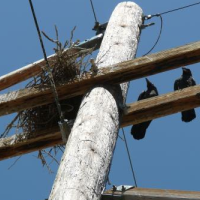Big Winners in Spread of Power Lines…Ravens
 (photo: Kristy Howe, Idaho State Univeristy)
(photo: Kristy Howe, Idaho State Univeristy)
Ravens are taking advantage of power poles in the United States, building nests atop them and using the poles’ height to help them target their prey. This is occurring particularly out West, where other species are being threatened by the large black birds.
A new study found the addition of transmission lines, along with other factors, are making life easier for ravens at the expense of other birds, such as the greater sage grouse.
In the western United States, raven populations have increased more than 300% over the last 40 years. Researchers discovered that the ravens had expanded eleven-fold in number between 1985 and 2009 on federal lands in southeastern Idaho.
They attributed the increase to the addition of transmission lines, roads, and other human construction. Ravens, considered to be highly intelligent, have demonstrated an ability to utilize human engineering for their own benefit. Other species, including hawks and eagles, are known to perch on power lines, but none have colonized them to the degree that ravens do.
The increase in ravens was bad news for the greater sage grouse, the endangered Desert Tortoise, the endangered San Clemente Loggerhead Shrike and the California Least Tern.
Researchers found that 58% of raven nests were located on transmission poles, far more than in trees (19%) or on other man-made structures (14%).
Fewer ravens’ nests were seen as the distance from power poles increased, according to the study by the Wildlife Conservation Society, Idaho State University and the U.S. Geological Survey.
The birds seemed to prefer the towering transmission poles because they afforded better viewpoints and increased speed during take-offs to attack their prey, as well as providing greater protection from predators and wildfires.
“By altering the landscape with roads, facility construction, billboards, and transmission lines, and in some cases providing sources of water and food, we are subsidizing ravens and providing them with the opportunities and advantages they need to excel in areas that they didn't before,” lead author Kristy Howe said in a press release. “This is bad news for the animals in that ecosystem upon which ravens prey.”
The use of the power lines is becoming ingrained in the species, passed through the generations, according to Howe. “They may be influencing other ravens and their own young—they were born on a power pole and they think that's where they should be nesting,” she told BBC News.
-Noel Brinkerhoff, Danny Biederman
To Learn More:
Might More Ravens—Aided by Humans—Mean “Nevermore” for Sage-Grouse? (Wildlife Conservation Society)
Power Line Nests Put US Ravens in Pole Position for Prey (by Matt McGrath, BBC News)
- Top Stories
- Unusual News
- Where is the Money Going?
- Controversies
- U.S. and the World
- Appointments and Resignations
- Latest News
- Trump to Stop Deportations If…
- Trump Denounces World Series
- What If China Invaded the United States?
- Donald Trump Has a Mental Health Problem and It Has a Name
- Trump Goes on Renaming Frenzy






Comments